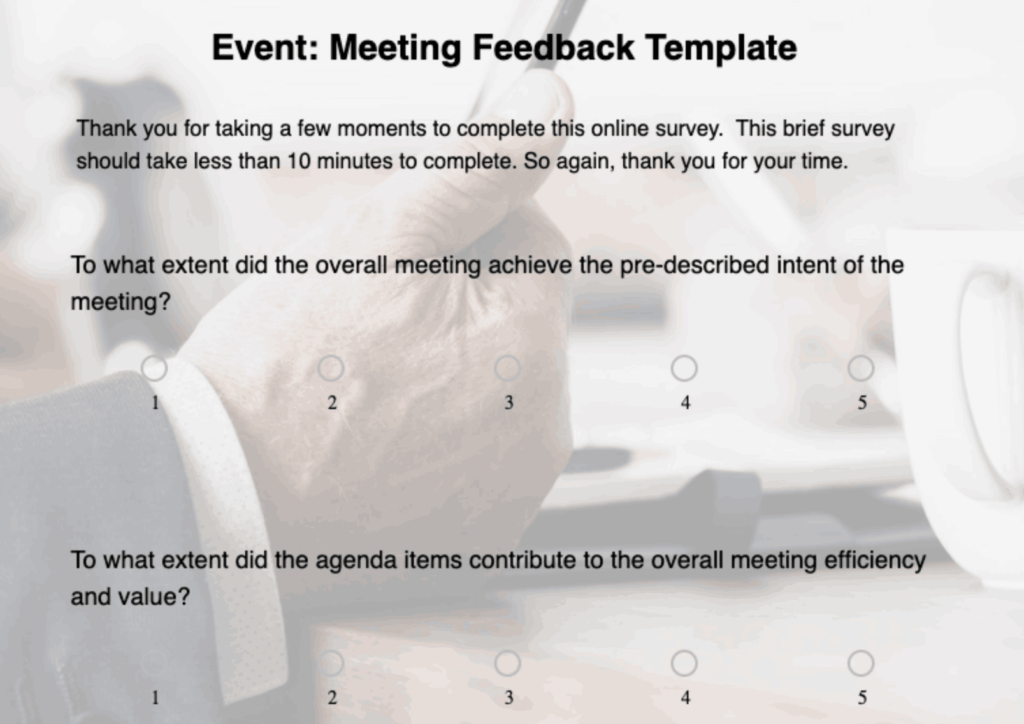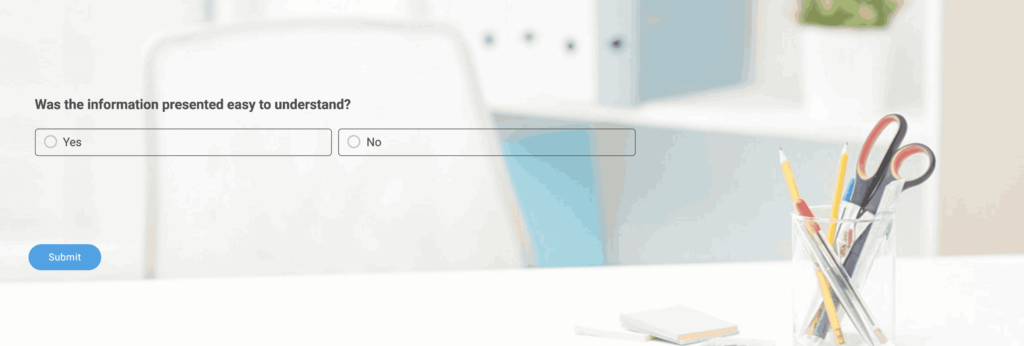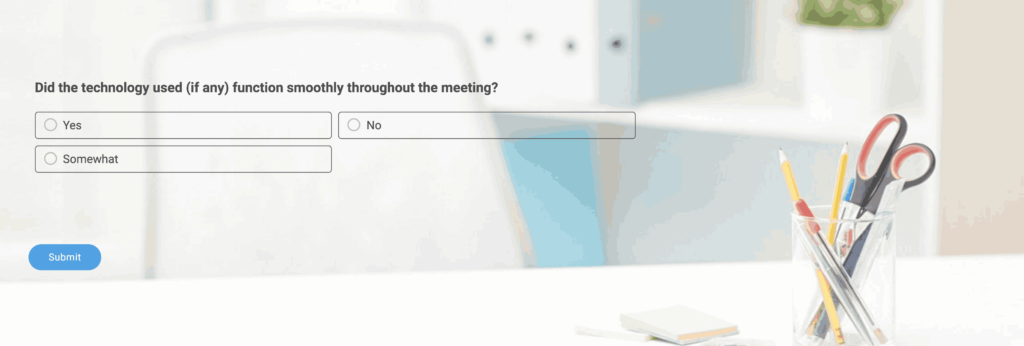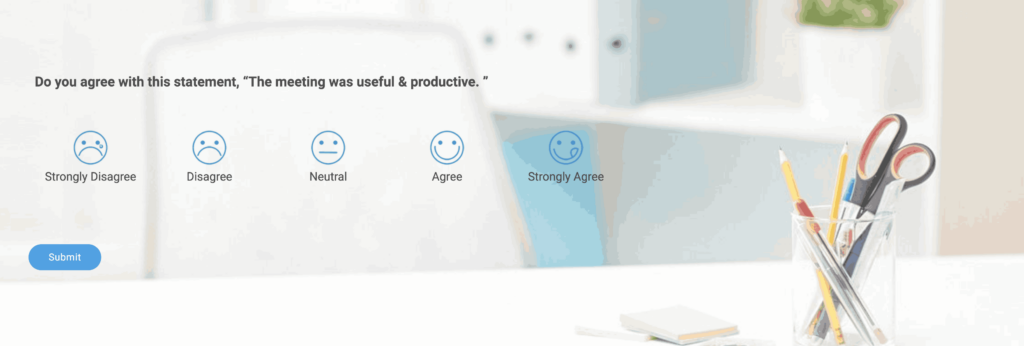![How to Craft Post-Meeting Survey Questions [Examples + Tips]](https://www.proprofssurvey.com/blog/wp-content/uploads/2024/09/How-to-Craft-Post-Meeting-Survey-Questions-Examples-Tips_4_11zon.png)
“Well, that could have been an email! ?”
After going through an hour (or three) of pointless meetings, we’ve all been there. Afraid that your team may think the same about your meetings? What if there was a way to find out? With a post-meeting survey, you can!
It’s a goldmine for valuable insights that can transform your meetings from time-sucks to strategic sessions on which your team thrives.
So, are you ready to ensure your meetings are meeting their goals?
Let’s explore the essential survey questions you need to ask, how to ask them, examples of questions, and expert-approved tips!
Watch: How to Create a Survey Using ProProfs Survey Maker
What Are Post-Meeting Survey Questions?
Post-meeting survey questions are designed to gather feedback from participants about the effectiveness and efficiency of a meeting. These questions help in identifying what worked well, what didn’t, and how future meetings can be improved.
These concise surveys provide insights into:
- Meeting Effectiveness: Did the meeting achieve its goals? Was it a productive use of time?
- Content & Clarity: Were the topics relevant and well-presented? Did everyone feel heard?
- Engagement & Participation: Did the meeting feel engaging? Were there opportunities for open discussion?
- Meeting Logistics: Did the meeting run smoothly? Was the space conducive to focused work?
By incorporating these questions, you can transform your meetings from obligatory gatherings into strategic sessions on which your team thrives.
30+ Post-Meeting Survey Questions to Try
1. Meeting Effectiveness
- To what extent did this meeting achieve its stated goals? (Strongly Achieved, Somewhat Achieved, Not Achieved)
- Was the agenda clear and followed effectively throughout the meeting? (Yes, No, Somewhat)
- Did the meeting feel like a productive use of your time? (Strongly Agree, Agree, Neutral, Disagree, Strongly Disagree)
- Considering the meeting’s objectives, was the allocated time sufficient? (Yes, No, Unsure)
- On a scale of 1 (Not at All Effective) to 5 (Extremely Effective), how effective was this meeting in achieving its goals? (1, 2, 3, 4, 5)

2. Content & Clarity
- Were the topics discussed relevant to your role and the meeting’s objectives? (Very Relevant, Somewhat Relevant, Not Relevant)
- Was the information presented easy to understand? (Yes/No)

- Did the speaker(s) provide enough context and background information for the topics covered? (Yes, No, Somewhat)
- Did everyone have a chance to contribute their ideas and perspectives? (Yes, No, Somewhat)
- On a scale of 1 (Not Clear at All) to 5 (Extremely Clear), how clear was the overall communication during the meeting? (1, 2, 3, 4, 5)
3. Engagement & Participation
- How engaged and interested did you feel throughout the meeting? (Highly Engaged, Somewhat Engaged, Disengaged)
- Did the meeting format (presentation, discussion, etc.) encourage active participation? (Strongly Agree, Agree, Neutral, Disagree, Strongly Disagree)
- Were there sufficient opportunities for open discussion and asking questions? (Yes, No, Somewhat)
- Did you feel comfortable sharing your thoughts and ideas during the meeting? (Very Comfortable, Somewhat Comfortable, Not Comfortable)
- Using emojis, how would you rate the overall meeting energy? ( Very Energetic, Somewhat Energetic, Neutral, Somewhat Draining, Very Draining)
4. Meeting Logistics
- Did the meeting start and end on time? (Yes, No)
- Was the meeting space conducive to focused discussion and collaboration? (Strongly Agree, Agree, Neutral, Disagree, Strongly Disagree)
- Did the technology used (if any) function smoothly throughout the meeting? (Yes, No, Somewhat)

- Were the pre-meeting materials (agenda, reports, etc.) helpful and informative? (Very Helpful, Somewhat Helpful, Not Helpful)
- On a scale of 1 (Not Well-Organized) to 5 (Extremely Well-Organized), how well-organized was this meeting? (1, 2, 3, 4, 5)
5. Knowledge & Action Items
- Did the meeting provide you with a clear understanding of the topics discussed? (Strongly Agree, Agree, Neutral, Disagree, Strongly Disagree)
- Do you feel confident in your ability to complete any assigned action items? (Yes, No, Somewhat Unsure)
- Were the next steps and action items clearly defined and communicated? (Strongly Agree, Agree, Neutral, Disagree, Strongly Disagree)
- Is there any additional information or resources you would need to complete your action items effectively? (Yes, No, Unsure)
- What specific action items did you take away from this meeting? (______________________)
6. General Feedback
- What was the most valuable aspect of this meeting for you?
- What, if anything, could have been done to improve the overall flow of the meeting?
- Would you like to see any recurring topics covered in a different format (e.g., shorter check-ins, non-ssynchronous communication)?
- Would you be willing to participate in a brief follow-up discussion on a specific topic from this meeting? (Yes, No)
- Is there anything else you would like to share about your experience in this meeting?
- What is one thing the organizer could do differently to improve your meeting experience in the future?
| Want to create a well-balanced post-meeting survey but don’t know where to start? Ask ProProfs AI Survey Generator to do it for you! |
Why Should You Ask Post-Meeting Survey Questions?
It’s true – meetings can often feel like an unproductive black hole for everyone’s time. However, they play an extremely crucial role in communicating goals, performance, information, and many other necessary, relevant data.
Since meetings are also time-intensive, it’s necessary to know whether they serve their intended purpose. Post-meeting surveys offer you that insight. Here are all the ways these surveys can help you:
Discover Blind Spots
Traditional feedback methods can be fraught with social bias. Team members might hesitate to voice concerns directly, especially in groups. Anonymous surveys create a safe space for honest feedback, revealing blind spots you might not have otherwise identified.
Imagine discovering a key topic that wasn’t adequately covered or that a specific team member felt excluded from the discussion. By uncovering these hidden gems, you can address them in future meetings, leading to more inclusive and productive sessions.
Data-Driven Improvement
Gone are the days of relying on gut instinct or anecdotal evidence. Post-meeting surveys provide quantifiable data that empowers you to make data-driven decisions. You can track trends over time, measure the effectiveness of implemented changes, and identify improvement areas.
This data-centric approach ensures your efforts to improve meetings are targeted and yield measurable results.
Boost Team Morale and Engagement
Actively soliciting feedback demonstrates that you value your team’s input and are committed to creating a positive meeting experience. It fosters a sense of ownership and increases team morale. When team members feel their voices are heard and valued, they’re more likely to come to meetings prepared, participate actively, and contribute their best ideas. It translates into more engaged and productive sessions for everyone.
Identify Knowledge Gaps
Sometimes, unproductive meetings can stem from a lack of clarity or shared understanding of the topic at hand. Feedback might reveal areas where team members need additional information or resources.
By pinpointing these knowledge gaps, you can proactively address them before future meetings. This ensures everyone arrives prepared to contribute effectively, leading to more focused and efficient discussions.
Promote Accountability
Soliciting feedback creates a culture of accountability. Organizers are held accountable for ensuring meetings are well-planned, run efficiently, and achieve their intended goals.
On the other hand, attendees are reminded to come prepared, actively participate, and contribute their valuable insights. This two-way accountability fosters a collaborative environment where everyone takes ownership of the meeting’s success.
By incorporating post-meeting survey questions, you’re not just gathering feedback; you’re investing in the future of your meetings. You’re creating a space for continuous improvement, fostering a more engaged team, and ultimately, achieving the strategic goals your meetings were designed to support.
How to Create an Effective Post-Meeting Survey?
Post-meeting surveys are your secret weapon, but wielding them effectively requires careful design. Here’s how to craft a concise and impactful survey:
Step 1 – Target Your Goals: Define what you want to learn before diving in. Is it meeting effectiveness, content clarity, or engagement? Knowing this guides your question selection.
Step 2 – Include a Variety of questions: To avoid monotony and gather comprehensive data, you can mix the question types in your survey. Ideally, include:
- Multiple Choice: Provides pre-defined answer options for quick selection.
- Rating Scale: Allows participants to rate their agreement with a statement (e.g., “The meeting agenda was clear” – Strongly Disagree, Disagree, Neutral, Agree, Strongly Agree)
- Open-ended (Text Box): Encourages participants to elaborate on their thoughts and experiences (e.g., “What did you find most valuable about today’s meeting?”)
Step 3 – Spruce Up the Survey: Use various survey elements to make the questionnaire seem appealing. This will likely encourage your respondents to carry on and complete it. You can use:
- Emoji Ratings: A fun way to gauge sentiment (e.g., smiley face for great, frown for poor).
- Catchy Themes & Multimedia: Capture attention with fun images while highlighting key takeaways visually.
Step 4 – Test and Refine: Don’t just write it and forget it! Pilot your survey with a small group before sending it out to the entire team. This allows you to identify any confusing questions or areas for improvement.

By following these steps, you’ll design a survey that gathers valuable data while keeping it quick and engaging. To ensure that, a good survey tool offering all these features is essential. Here’s a short video that’ll help you choose the right post-meeting feedback survey tool.
Watch: How to Choose the Best Survey Software
What Are the Best Practices for Meeting Feedback Surveys?
Crafting an effective post-meeting survey is just the first step. To unlock the true potential of this feedback goldmine, here are some best practices to ensure you’re gathering actionable data and implementing it for continuous improvement:
- Timing is Key: Don’t let those precious insights fade! Send surveys promptly after the meeting, ideally within 24 hours. This ensures responses are based on fresh memories and leads to higher-quality data.
- Keep it Anonymous: Guarantee anonymity to encourage honest and candid feedback, especially for sensitive topics. You can use anonymous survey tools or simply avoid collecting any personally identifiable information (PII).
- Focus on Actionable Feedback: While open-ended questions are valuable, don’t neglect the power of multiple-choice and Likert scale options. These provide clear data points that can be easily analyzed and translated into actionable improvements.
- Close the Loop: Demonstrate that you value feedback by sharing key takeaways and planned improvements based on the survey results. This transparency fosters trust and encourages continued participation. You can do this through a follow-up email or a quick announcement at the start of the next meeting.
- Use Technology to Your Advantage: Numerous online survey platforms and tools are available that can streamline the creation, distribution, and analysis of your surveys. Explore options that integrate with your existing calendar or project management software for a seamless workflow.
- Tailor It to the Meeting Type: One-size-fits-all doesn’t apply here. Adapt your survey questions to the specific meeting type (brainstorming session, status update, project deep-dive). This ensures you’re gathering the most relevant feedback for each type of interaction.
- Pre-Populate Certain Fields: Save time for participants by pre-populating basic information like the meeting title, date, and organizer. This reduces survey fatigue and encourages higher completion rates.
- Add Visuals: People process visuals more effectively than text. Consider incorporating star ratings, progress bars, or even emoji scales alongside traditional answer options. This can make the survey more engaging and provide valuable at-a-glance insights.
- Test Your Survey: Conduct a pilot test with a small group before releasing the survey. This allows you to identify any confusing questions, unclear instructions, or technical glitches. A smooth survey experience leads to more reliable data.
- Set Response Deadlines: While anonymity is key, setting a reasonable deadline for responses ensures you gather the freshest feedback while it’s still top-of-mind. This allows you to analyze the data and potentially address concerns before the next meeting.
- Be Mindful of Survey Length: Strive for a survey that can be completed in 3-5 minutes. Prioritize the most critical questions and consider using branching logic to avoid bombarding participants with irrelevant options.
Make Your Meetings a Success By Implementing Post-Meeting Survey Feedback
Meetings can be a double-edged sword—essential for collaboration but sometimes a drain on productivity. However, post-meeting surveys can be your secret weapon, transforming these sessions from obligatory gatherings to strategic wins.
These surveys are more than just a formality – they’re a window into your team’s experience, uncovering blind spots, promoting accountability, and, ultimately, fostering a more engaged and productive meeting environment.
So, the next time you find yourself in a potentially unproductive meeting, remember this: with the right post-meeting survey questions in your arsenal, you can turn that time into a springboard for success.
To know more, sign up for free or get a demo.
FREE. All Features. FOREVER!
Try our Forever FREE account with all premium features!





